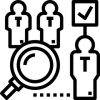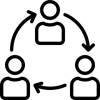 Menu
Menu
Moving towards New Age Technology Applicant Tracking System (ATS)

Learn About What is an applicant tracking system and why you need it for the recruitment process. Explore the benefits, how it works, and improve your recruitment systems
The Applicant Tracking System (ATS) is an essential HR software used in streamlining the recruitment process. An ATS swiftly sifts through applications, ensuring no talent goes unnoticed. It’s a must-have recruitment management system in today’s competitive landscape, automating tasks and centralizing data for enhanced hiring experiences. By handling time-consuming aspects, ATS allows HR teams to focus on other crucial recruitment facets that mandate active human involvement. With its ability to seamlessly manage and organize candidate data, ATS significantly simplifies the recruitment system. Ultimately, integrating ATS into your processes not only saves time but also ensures that top-tier candidates are efficiently identified and brought on board, giving your organization an edge in talent acquisition.

What is an Applicant Tracking System (ATS)?
An Applicant Tracking System is an automated recruitment software that serves as an effective facilitatory tool for the HR and recruitment departments during the hiring process. ATS software enhances the hiring process and makes the recruitment workflow seamless and swift. From job advertising to managing interviews and everything in between, be it applicant data management, resume storage and parsing, candidate screening, or any other requirement, ATS recruitment has got all that covered. This recruitment software possesses a range of functionalities to improve the hiring experience for both the recruiters and the candidates. It’s a highly productive, time-saving boon to have in your arsenal.
What are the 10 Most important features of Applicant Tracking System (ATS)?
An Applicant Tracking System (ATS) is a powerful tool used by HR professionals and recruiters to streamline the hiring process. Its features include job posting, resume parsing, and candidate database management, enabling efficient sourcing and organization of applicants. ATS offers collaborative functions, allowing the HR and recruitment teams to review and assess candidates as a coordinated unit. Its integration with communication tools ensures timely candidate interactions.
ATS recruitment also enhances the candidate experience by offering personalized communication and status updates. Its analytical capabilities provide insights into recruitment metrics, aiding in data-driven decision-making. Overall, ATS optimizes recruitment workflows, reduces manual efforts, ensures compliance, and above all, paves the way for a more effective and organized hiring process.
The following are some of the key features that an ATS needs to have:
- Job/Requisition Management : The job/requisition management feature in an Applicant Tracking System (ATS) streamlines job posting, approval, and tracking, ensuring seamless collaboration between the HR and recruitment teams, thereby facilitating a structured and seamless recruitment process.
- Process Oriented, Process Management: The process-oriented, process management feature of an ATS navigates the recruitment through defined workflows, automating tasks such as candidate reviews, interview scheduling, and collecting feedback. This helps maintain consistency in these processes, minimizes delays, and enhances overall hiring efficiency.
- Job Boards Integration : Maximizing the reach and increasing the visibility of your job opening is a reality in just a few clicks with the job boards integration feature of an ATS. An ATS helps create a job post and lets you publish it instantly on several leading recruitment sites, social networking platforms, career pages, etc. ATS also lets you track the performance of each of those platforms on which it publishes your job, apart from possessing job promotion capabilities, so that you can better strategize your job distribution.
- Integrated Career Portal : Career pages play a pivotal role in impressing interested job seekers. Many ATSes offer fully integrated, branded career portals that are easy to set-up, and configure, have text and picture data input and display compatibility, to showcase an effective reflection of your company’s aims, culture, and values. ATS also offers social sharing options for you to market your career page on the leading social networking platforms.
- Resume Management : ATS collects all the candidate applications from the various job publishing platforms, and stores them in an organized manner in its centralized database. The ATS can sift through large volumes of applications and pick the best available candidates from the lot that suits your job the best owing to its resume management capabilities. To give the recruiters the best-matched candidates for a particular job, an ATS must possess a wide range of filters, with all the custom fields that are relevant to your company. It should be able to match the set criteria and filters accurately, and display results that could be sorted, shared, and saved. Usually, an ATS uses certain keywords and set criteria to sort and organize candidate applications.
- Onboarding : An ATS offers a seamless onboarding process after a candidate is hired. Be it transferring the candidate’s application information, welcoming the new hire, familiarizing them with your company, educating them about their job, or quick initiation of their training process, everything happens with ease thanks to ATS. Through ATS, you can also digitize relevant paperwork, and let employees e-fill and e-sign important forms and documents respectively.
- Social Media Integration : The social media integration function of an ATS enables you to easily share your job posts to the various social media platforms, alongside the job boards. It helps you attract passive candidates on the web who aren’t actively looking for job opportunities online. Their experience and skills make them worthy enough to target and convince them with a compelling job offer.
- CRM : ATS aids Customer Relationship Management (CRM) by centralizing contacts and candidate data, facilitating personalized communication, and tracking interactions. This integration enhances candidate engagement, nurtures better relationships with your leads/clients, and improves the efficacy of the recruitment process.
- VMS : The VMS (Vendor Management System) streamlines the hiring process by enabling organizations to manage multiple staffing agencies efficiently. It serves as a centralized platform for managing and processing candidate submissions obtained from various sources. It simplifies communication, and provides valuable analytics, enhancing overall recruitment effectiveness. It also helps in tracking vendor performance, ensuring compliance with hiring policies, and optimizing cost control. It promotes transparency and collaboration between hiring teams and external partners, making it an essential tool for large enterprises and companies with extensive staffing requirements.
- Timesheet, Invoicing and Payroll Management : The timesheet, invoicing, and payroll management feature in an Applicant Tracking System automates and simplifies various HR and financial processes. It keeps track of employees’ work hours, ensuring precise payroll processing. Moreover, it streamlines the creation and submission of invoices to clients or vendors, ensuring on-time payments and improving cash flow management. It increases efficiency, reduces errors, and ensures compliance with labor and financial regulations.
How Does an Applicant Tracking System Work?
An Applicant Tracking System (ATS) plays a critical role in modern industries by streamlining and optimizing the recruitment process. This hiring software works by automating the entire journey of a job application, from posting vacancies to onboarding fresh recruits. Here’s how Applicant Tracking Software functions:
- Job Posting : Employers create and post job listings on various platforms, and the ATS ensures they are widely distributed online, reaching a larger pool of potential candidates.
- Resume Screening : When candidates apply, the ATS scans their resumes, extracting and organizing key information. It then ranks and filters applicants based on predefined criteria, saving recruiters time by eliminating irrelevant applications.
- Communication : ATS facilitates seamless communication between recruiters and applicants, sending automated emails, interview invitations, and status updates.
- Interview Management : It schedules interviews, tracks candidate responses, and records interview feedback.
- Assessment and Evaluation : ATS may include assessment tools to gauge candidates’ skills and qualifications.
- Onboarding : Once a candidate is selected, ATS generates offer letters and manages the onboarding process.
- Analytics : It provides valuable data and analytics on recruitment metrics, helping organizations make data-driven hiring decisions.
ATS significantly reduces administrative tasks, accelerates the hiring process, and ensures compliance with regulations, making it a must have tool which bolsters your recruitment management system.
5 Top Benefits of Using a Good Recruitment Software
Quality recruitment software streamlines the hiring process, and saves time and resources by automating tasks like resume screening, interview scheduling, and candidate tracking. This leads to faster hiring, reducing the time-to-fill vacancies.
Secondly, its data-driven analytics to match candidates with job requirements and objective qualification assessment enhances candidate selection, minimizes the risk of bad hires, and improves long-term employee retention.
Additionally, applicant tracking software promotes collaboration among hiring teams by providing a centralized platform for communication and feedback, ensuring everyone is on the same page throughout the hiring process.
Moreover, it thoroughly ensures compliance with equal opportunity and anti-discrimination laws by standardizing and documenting hiring procedures. Let us look at certain specific benefits of ATS software and why it is such an indispensable tool for HR departments in today’s landscape.

Improved Efficiency

Improved Efficiency

Improved Efficiency

Improved Efficiency

Improved Efficiency
TrackTalents enhanced Recruitment Software and effective Solutions
TrackTalents enhanced Recruitment Software and effective Solutions simplify and streamline the entire hiring process. It begins with job posting and distribution across multiple platforms, ensuring maximum visibility. As the applications start coming in, the ATS collects and organizes these resumes into a centralized database, making it easy to search and filter candidates based on different criteria.
Our ATS recruitment software automates resume screening by matching candidate qualifications with job requirements, saving the recruiter valuable time. It also facilitates interview scheduling, communication, and feedback sharing within hiring teams.
Besides, it offers insightful analytics, tracking key metrics like time-to-fill, source efficacy, and candidate conversion rates. These data-driven insights help recruiters make informed decisions, optimize recruitment strategies, and improve overall efficiency.
In Addition, TrackTalents’ ATS solutions include features for compliance management, ensuring adherence to equal opportunity and anti-discrimination laws. Hence TrackTalents’ recruitment software is arguably among the best talent acquisition ATS software out there.
What Questions Should You Ask Recruitment Software Companies to Evaluate the ATS Product?
Do I need this ATS feature for my business?
To determine your ATS function requirements, begin by assessing your current recruitment system and identifying pain points. Discuss it with key stakeholders, which include recruiters and hiring managers, to understand their needs. Once you have a clear picture of your requirements, you can work with recruitment software companies to select an ATS that aligns precisely with your business requirements, optimizing your recruitment efforts and investment.
Does this system align with our recruiting strategy?
Understanding if the ATS aligns with your recruiting strategy is critical to ensure the software enhances and complements existing practices, maximizing performance, and assisting long-term recruitment goals effectively.
How is the ATS system priced?
Every feature added to an ATS increases its cost. You need to get a thorough understanding of what features are essential for your company to escape overspending on unnecessary functionalities. Ask about the pricing structure and the factors it is based on. Furthermore, enquire if there are any hidden charges or ongoing costs involved with the product.
Do you offer high-quality local customer support?
Understanding if the ATS aligns with your recruiting strategy is critical to ensure the software enhances and complements existing practices, maximizing performance, and assisting long-term recruitment goals effectively.
Do ATS Vendors Update Their Products Often?
Inquiring about regular updates from the ATS vendor is important to ensure that the software remains contemporary, secure, and competitive. Regular updates are an indication of a commitment to improvement, addressing evolving needs and enhancing functionality.
Should I Purchase Standalone ATS Software or an Integrated Suite?
Determining the need for a standalone ATS or integrated suite is critical to aligning your software with your specific recruitment necessities and current tech stack, ensuring seamless workflow integration and performance.
What Are the Drawbacks of an ATS?
Understanding the drawbacks of an ATS is vital to making an informed selection. It aids in assessing potential limitations, which include complexity, cost, or compatibility issues, ensuring you select software that aligns with your recruitment needs and expectations.